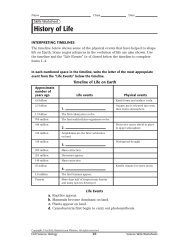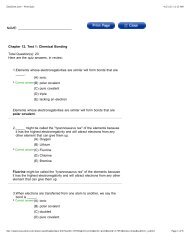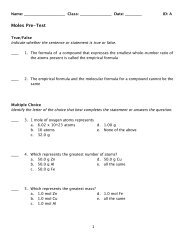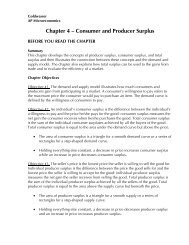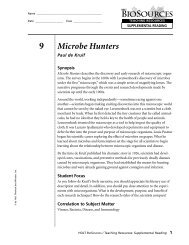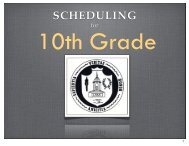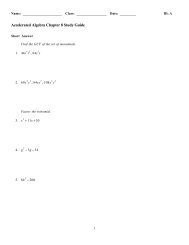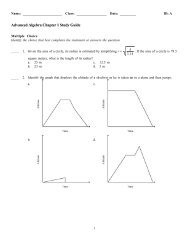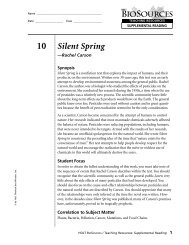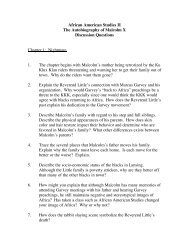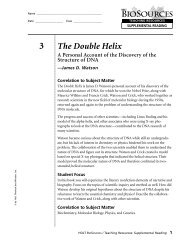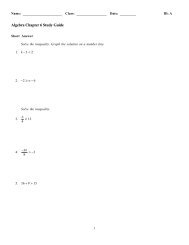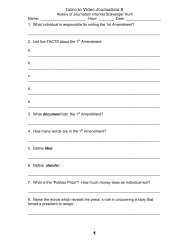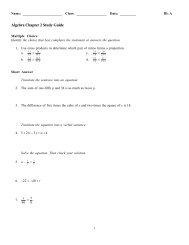Harlem Ren Poetry Project
Harlem Ren Poetry Project
Harlem Ren Poetry Project
Create successful ePaper yourself
Turn your PDF publications into a flip-book with our unique Google optimized e-Paper software.
<strong>Harlem</strong> <strong>Ren</strong>aissance <strong>Poetry</strong> <strong>Project</strong>This project is in two parts: an oral presentation of a poem and an analysis of that poem.The written analysis is due the day of your presentation. You will receive two grades, agrade for each part.Oral Presentation1. You must recite a minimum of 20 lines or more to qualify for an “A;” 14-19 linesfor a “B;” 10-13 lines for a “C.”2. You may combine two or more poems to meet the number of lines. You may alsorecite part of a lengthy poem to meet the number of lines. Be sure to stop in alogical place in the poem.3. Memorize the poem(s) for recitation.4. Express the poem from a personal point of view.a. Dramatize the poem during your recitation.b. During your recitation provide background music that captures the moodof the poem.c. During your recitation play a musical instrument that captures the mood ofthe poem.5. After your recitation, select a couple of lines from the poem that you particularlylike and explain why. What do these lines say to you?6. For this project select your poem from the list below. Note the number of lines ineach poem indicated in parentheses.Selection of Poems for the <strong>Project</strong>“<strong>Harlem</strong>” (11) “Ballad of the Landlord” (32)“Dreams” (8) “Sugar Hill” (12)“I, Too” (18) “Weary Blues” (24)“Mother to Son” (20) “The Edge of Hell” (19)“Tropics in New York” (12) “Because My Mouth Is Wide (15)“Baptism” (14) “Why?” (8)“If We Must Die” (14) “Dream Boogie” (18)“America” (14) “Children’s Rhymes” (24)“Yet Do I Marvel” (14) “Theme for English B” (40)“Tableau” (12) “Same in Blues” (32)“Incident” (12) “Motto” (9)“Sugar Hill” (12) “Merry-Go-Round” (13)“Let America Be America Again” ( 86 )
How To Understand a Poem1. Look at the title to learn about the subject or the theme.2. Read the poem for complete thoughts instead of reading it line by line. What iseach complete thought saying?3. Know the meanings of all the words in the poem. Look up unusual words orwords used in an unusual manner.4. Identify the speaker (the persona) of the poem. Is it the author or someone he hascreated?5. Pay attention to the poet's use of key words, imagery, and figures of speech.What feelings do they suggest? Point out and explain symbols and allusions.6. Listen for sound effects. Are any words repeated? Are any ideas emphasizedthrough repetition?7. Using the information from the previous six steps, what do you think the poem issaying? Express this meaning in your own words. What do you think the poetmay have felt or thought? How does the poem make you feel?
Writing the <strong>Poetry</strong> AnalysisRemember, a theme is the author’s comment about people, society, or the universe ingeneral. A literary work is not limited to one theme. As long as you can support yourtheme from the literature, it is valid.A theme is NOT a plot summary. It does NOT tell what happens in the poem. A themeis also NOT a moral. It does NOT teach a lesson or tell how a person should behave.1. For the analysis include the title of the poem and its author.2. In the first paragraph state what you think is the theme of the poem.3. In the second paragraph state what happens in the poem to support your themestatement. Use direct quotations from the poem to illustrate your theme.Remember to follow each direct quotation with a brief analysis.A Sample AnalysisA Theme Analysis of “Incident” by Countee CullenWith his poem “Incident” Countee Cullen comments that when a personexperiences a saddening or disheartening incident, he remembers it more than any otherincident he might have enjoyed.In Cullen’s poem, an eight-year-old black boy visits the city of Baltimore andattempts to befriend a young white boy about the same age. The eight-year-old “. . . sawa Baltimorean. . .[who] was no whit bigger, And . . .smiled. . .” Reaching out to a strangerin this way, the black youth displays an innocent yet courageous desire to connect withanother child. The white youth, however, rejects him by “. . .[poking] out His tongue, and[calling him], ‘Nigger’.” The boy’s act of sticking out his tongue and using a racialepithet make the refusal of friendship insulting and offensive. Although the blackyoungster stays in Baltimore “. . .from May until December,” he reminisces “Of all thethings that happened there That’s all that [he remembers].” Understandably, the painfulexperience becomes a negative memory.



